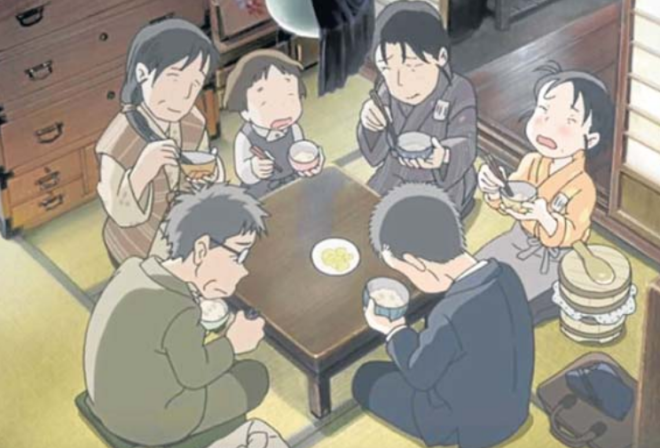

The spotlight is on animé and manga when Eiga Sai, the yearly Japan film festival in Manila, opens July 1 with the screening of an award-winning, manga-based animated film at the Dream Theater of the Cultural Center of the Philippines (CCP). The venue commemorates the 20th anniversary of the festival as CCP hosted its maiden edition in 1997.
Staged by the Japan Foundation and Embassy of Japan, Eiga Sai 2017 will open with “In This Corner of the World,” which won Animation of the Year at the 2016 Japan film academy awards.
Based on a manga (graphic novel) by Fumiyo Kono, about an artist who becomes a soldier’s wife and homemaker in wartime Japan, the film is a rarity in the age of digital animation and filmmaking.
“It is hand-drawn artwork, with CGI (computer-generated imagery) limited to background in battle sequences,” festival lecturer Jaqueline Berndt said in an e-mail interview.
The film’s modest attributes—crowd-funding 20 percent of the entire production budget, targeting only a domestic audience, having limited distribution in Japan—have not prevented it from gaining fans worldwide.
Berndt said it went viral on social networks and even became popular among middle-age Japanese men, a demographic not inclined toward movies about young women.
“Those of you who think animé is something for kids or nerds might change your opinion,” said Berndt.
“‘In This Corner of the World’ is a story… about the strength of women and the power of the drawing hand,” she added.
25 years
Berndt is a Japanese language and culture expert who spent 25 years as an academic in Japan. She now teaches in Stockholm University where she has established a new course called Manga Studies.
As director of the traveling exhibit, “Manga Hokusai Manga: Approaching the Master’s Compendium from the Perspective of Contemporary Comics,” Berndt will visit Manila to introduce and give a tour of the show.
Ateneo Art Gallery in Quezon City is the venue for the exhibit’s Manila leg.
“Manga Hokusai Manga” debuted in Rome and made stops in other European cities before heading to Asia, starting in Hanoi, Vietnam.
The exhibit features manga by seven contemporary artists alongside the work of Katsushika Hokusai, who created one of the most recognized pieces of Japanese art, the woodblock print titled “The Great Wave.”
In his 50s, the prolific Hokusai started making for his students a reference book for pictorial art and graphic design, “which had everything and anything in a variety of styles such as Chinese, Japanese, Western,” said Berndt. Hokusai called the book “manga,” meaning “diverse images.”
“The Manga demonstrate the width of his (Hokusai’s) prowess, but also his humor and creativity,” she said.
Progenitor
With about 4,000 images on over 800 pages spread out in 15 booklets published between 1814 and 1878, it’s no wonder that fans and historians would later on look to Hokusai as progenitor of manga.
But, said Berndt, “Our exhibition suggests the opposite: to employ the perspective of contemporary comics and look back, asking what the Hokusai Manga actually have to do with them. They (contemporary and Hokusai manga) do not resemble each other stylistically, but have a lot in common culturally.”
The aim is to bring together manga readers and people who may not be fans of the medium but have an appreciation for artists like Hokusai.
There is no better example of how the exhibit engages visitors than when families visit the show, said Berndt. The young ones would teach their parents about contemporary manga while parents end up exploring the exhibit with their kids and in the process both generations gain a wider understanding of the medium.
New manga artists may not necessarily want to pick up Hokusai’s style and aesthetic, but they can be inspired by the work ethic of the so-called “old man crazy about drawing.”
“They can learn a specific attitude, a profound curiosity, an incessant commitment to drawing (beyond commercial or political concerns),” said Berndt.
A few things to learn about form, she continued, include “how to assemble and juxtapose diverse things, how to attract curiosity toward manifoldness of life.”
“Life implies movement, and Hokusai is a master of ‘animation,’ so to speak,” Berndt said. “Although the Manga pictures don’t move, they give the impression of being alive.”
“In This Corner of the World” and Jaqueline Berndt’s lecture-introduction is on July 1, 4 p.m., at the CCP Dream Theater.
The 20th Eiga Sai’s grand opening is on July 6, 7:30 p.m., at Shangri-La Plaza Cineplex, Mandaluyong City. The festival runs July 1-Aug. 29 in Metro Manila and in Davao, Cebu, Baguio, Bacolod, Iloilo.
“Exhibiting Manga: Intentions, Difficulties, and Potentials,” a lecture also by Berndt, is on June 30, 3:30-5 p.m., at Natividad Galang Fajardo Room, De la Costa Hall, Ateneo de Manila University.

